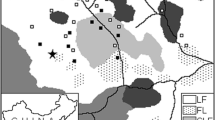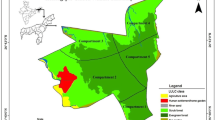Abstract
The mara is a near threatened Caviomorph, endemic to Argentina. Studies on feeding ecology allow assessment of the dietary adaptability of maras to habitat changes. The mara diet and food availability on two sampling sites, belonging to distinct landscapes of Northern Patagonia, were estimated using microhistological analysis and point-quadrat transects, over four seasons, and besides during an extended drought. Significant differences were detected by Kruskall-Wallis ANOVA, feeding selection by the χ2 test, and dietary preferences by Bailey’s confidence interval. Grasses dominated food availability, with Panicum and Poa as major species, followed by shrubs and scarce forbs. Plant cover and forbs increased in spring and summer. The drought caused a strong decrease in plant cover and proportion of grasses. Maras ate all grass species, most forbs and several shrubs. Grasses dominated the diet, with Poa and Panicum being the major species, supplemented by the shrubs Lycium and Prosopis. Maras ate more grasses and forbs in spring and summer, and shrubs in autumn and winter. More shrubs and forbs, and less grasses, were eaten during the drought. Plant categories were used selectively only in autumn and winter, and in the drought period, with preference for shrubs and avoidance of grasses. Bromus, Poa, Plantago and Prosopis were preferred, and Panicum avoided. The mara qualified as a grazer but shifted to a mixed feeder during the drought. Dolichotis patagonum shared habitats with several big and medium-sized herbivores and showed the highest dietary similarities with plain vizcachas, brown hares and horses. Protective measures for natural habitats are needed, given that increasing impacts on food resources and habitat quality could be threats to the survival of maras and other wild vertebrates in Northern Patagonia.
Similar content being viewed by others
References
Abraham, E., 2000. Geomorfologia de la provincia de Mendoza. In: Abraham, E., Rodríguez Martínez, F. (Eds.), Argentina, Recursos y Problemas Ambientales de la Zona Árida. Junta de Andalucía, Gobierno y Universidades de la Región Andina Argentina, Buenos Aires, pp. 29–48.
Abraham, E., del Valle, H.F., Roig, F., Torres, L., Ares, J.O., Coronato, F., Godagnone, R., 2009. Overview of the geography of the Monte Desert biome, Argentina. J. Arid Environ. 73, 144–153.
Baldi, R., 2004. In: Selección de Hábitat y éxito Reproductivo en la mara. II Reunión Binacional de Ecología, Mendoza.
Baldi, R., 2007. Breeding success of the endemic mara Dolichotis patagonum in relation to habitat selection: conservation implications. J. Arid Environ. 68, 9–19.
Baumgartner, L.L., Martin, A.C., 1939. Plant histology as an aid in squirrel food-habit studies. J. Wildl. Manage. 3, 266–268.
Bonino, N., Sbriller, A., Manacorda, M., Larosa, F., 1997. Food partitioning between the mara (Dolichotis patagonum) and the introduced hare (Lepus europaeus) in the Monte desert, Argentina. Stud. Neotrop. Fauna Environ. 32, 129–134.
Bothma, J., du, P., van Rooyen, N., van Rooyen, M.W., 2004. Using diet and plant resources to set wildlife stocking densities in African savannas. Wildl. Soc. Bull. 32, 840–851.
Cabido, M., González, C., Acosta, A., Díaz, S., 1993. Vegetation changes along a precipitation gradient in Central Argentina. Vegetatio 109, 5–14.
Cabrera, A., 1953. Los roedores argentinos de la familia Caviidae. Publicaciones de Escuela Veterinaria. Universidad de Buenos Aires 6, 1–93.
Cabrera, A.L., Willink, A., 1980. In: Biogeografía de América Latina Second ed. Biological Series of the Organization of American States, Washington.
Campanella, M.V., Bertiller, M.B., 2008. Plant phenology, leaf traits and leaf litterfall of contrasting life forms in the arid Patagonian Monte, Argentina. J. Vegetation Sci. 19, 75–85.
Campos, C.M., Tognelli, M.F., Ojeda, R.A., 2001a. Dolichotis patagonum. Mamm. Species 652, 1–5.
Campos, C., Ojeda, R., Monge, S., Dakar, M., 2001b. Utilization of food resources by small and medium-sized mammals in the Monte Desert biome, Argentina. Aust. Ecol. 26, 142–149.
Cherry, S., 1996. A comparison of confidence interval methods for habitat use-availability. J. Wildl. Manage. 60, 653–658.
Chillo, M.V., 2007. Selectión de dieta del conejo de los palos (Pediolagus salinicola) y la mara (Dolichotis patagonum) durante la estación seca en un sitio de coexistencia. Thesis, Univ. Nac. Córdoba, Argentina.
Colwell, R.K., Futuyma, D.J., 1971. On the measurement of niche breadth and overlap. Ecology 52, 567–576.
Consejo Federal de Inversiones, 1977. Proyecto de desarrollo ganadero del oeste de La Pampa, Tomo I. Buenos Aires.
Daget, P., Poissonet, J., 1971. Une méthode d’analyse phytologique des prairies. Critéres d’application. Ann. Agron. 22, 5–41.
Dubost, G., Genest, H., 1974. Le’comportement social d’une colonie de maras Dolichotis patagonum Z. dans le Parc de Branféré. Z. Tierpsychol. 35, 225–302.
Duci, J.L., 1949. Methods for the determination of food habits by plant microtechniques and histology and their application to cotton tail rabbit food habits. J. Wildl. Manage. 13, 295–298.
Fernández, O.A., Busso, C.A., 1999. Arid and semi-arid range-lands: two thirds of Argentina. RALA Report 200, 41–60.
Fiori, S.M., Zalba, S.M., 2003. Potential impacts of petroleum exploration and exploitation on biodiversity in a Patagonian Nature Reserve, Argentina. Biodivers. Conserv. 12, 1261–1270.
González Díaz, E.F., 1972. Descripción geológica de la Hoja 30-d, Payún Matru (Mendoza). Carta Geológico-Económica de la República Argentina, Boletín 130. Directión Nacional de Geología y Minería, Buenos Aires.
González Díaz, E.F., 1979. Descripción geológica de la Hoja 31-d, La Matancilla (Mendoza). Carta Geológico-Económica de la República Argentina, Boletín 173. Dirección Nacional de Geología y Minería, Buenos Aires.
Gutman, R., Choshniak, I., Kronfeld-Schor, N., 2006. Defending body mass during food restriction in Acomys russatus: a desert rodent that does not store food. Am. J. Physiol. Regul. Integr. Comp. Physiol. 290, 881–891.
Holechek, J.L., 1982. Sample preparation techniques for microhistological analysis. J. Range Manage. 35, 267–268.
Holechek, J., Gross, B., 1982. Evaluation of different calculation procedures for microhistological analysis. J. Range Manage. 35, 721–723.
Jaksic, F., 1989. Opportunist, selective, and other often-confused terms in the predation literature. Rev. Chil. Hist. Nat. 62, 7–8.
Kufner, M.B., Sbriller, A.P., 1987. Composición botánica de la dieta del mara (Dolichotis patagonum) y del ganado bovino en el monte mendocino. Rev. Argent. Prod. Anim. 7, 255–264.
Kufner, M.B., Chambouleyron, M.B., 1991. Actividad espacial de Dolichotis patagonum en relación a la estructura de la vegetación en el Monte Argentino. Stud. Neotrop. Fauna Environ. 26, 249–255.
Kufner, M.B., Sbriller, A.P., Monge, S.A., 1992. Relaciones tróficas de una comunidad de herbívoros del Desierto del Monte (Argentina) durante la sequía invernal. Iheringia, Ser. Zool. 72, 113–119.
Martínez Carretero, E., 2004. La Provincia fitogeográfica de La Payunia. Bol. Soc. Argent. Bot. 39, 195–226.
Martínez Carretero, E., Dalmasso, A., 1993. Flora y vegetation. In: Diseño del plan de manejo para Reserva La Payunia (Mendoza, Argentina). Multequina 2, 19–22.
Novaro, A., Walker, S., Funes, M., Radovani, N., Bolgeri, M., Puig, S., Videla, F., 2007. Conservation strategy for guanacos in northern Patagonia based on landscape connectivity. III Reunión Binacional de Ecología. La Serena, Chile.
Ojeda, R., Pardiñas, U., 2008. Dolichotis patagonum. In: 2008 IUCN Red List of Threatened Species.
Puig, S., Videla, F., Monge, S.A., Roig, V.G., 1996. Seasonal variations in guanaco diet (Lama guanicoe Müller 1776) and in food availability in Northern Patagonia, Argentina. J. Arid Environ. 34, 215–224.
Puig, S., Videla, F., Cona, M.I., 1997. Diet and abundance of the guanaco (Lama guanicoe Müller 1776) in four habitats of Northern Patagonia, Argentina. J. Arid Environ. 36, 343–357.
Puig, S., Videla, F., Cona, M.I, Monge, S.A., Roig, V.G., 1998. Diet of the vizcacha (Lagostomus maximus), habitat preferences and food availability in Northern Patagonia, Argentina. Mammalia 62, 191–204.
Puig, S., Videla, F., Cona, M.I., Monge, S.A., 2001. Use of food availability by guanacos (Lama guanicoe) and livestock in Northern Patagonia (Mendoza, Argentina). J. Arid Environ. 47, 291–308.
Puig, S., Videla, F., Cona, M.I., Monge, S.A., 2006. Relaciones dietarias entre herbivoros silvestres y domésticos en un área protegida de Patagonia septentrional (Mendoza, Argentina). In: Durán, V., Cortegoso, V. (Eds.), Arqueología y ambiente de áreas naturales protegidas de la provincia de Mendoza (Special Issue 61, Anales de Arqueología y Etnología). Univ. Cuyo Press, Mendoza, pp. 237–262.
Puig, S., Videla, F., Cona, M.I., Monge, S.A., 2007. Diet of the brown hare (Lepus europaeus) and food availability in northern Patagonia (Mendoza, Argentina). Mamm. Biol. 72, 240–250.
Ravetta, D.A., Goffman, F., Pagan, E., McLaughlin, S.P., 1996. Grindelia chiloensis resin and biomass production in its native environment. Ind. Crops Prod. 5, 235–238.
Redford, K.H., Eisenberg, J.F., 1992. In: Mammals of the Neotropics: The Southern Cone. Univ. Chicago Press, Chicago.
Rodriguez, M.D., 2009. Modeling habitat use of the threatened and endemic mara (Dolichotis patagonum, Rodentia, Caviidae) in agricultural landscapes of Monte Desert. J. Arid Environ. 73, 444–448.
Rodriguez, M.D., Dacar, M., 2008. Composición de la dieta de la mara (Dolichotis patagonum) en el sudeste del Monte pampeano (La Pampa, Argentina). Mastozool. Neotrop. 15, 215–220.
Roig, F.A., Martinez Carretero, E., Méindez, E., 1996. Mapa de vegetación de Mendoza (1:1.000.000). Multequina 5 Addenda.
Rosi, M.I., Cona, M.I., Videla, F., Puig, S., Monge, M.A., Roig, V.G., 2003. Diet selection by the fossorial rodent Ctenomys mendocinus inhabiting an environment with low food availability (Mendoza, Argentina). Stud. Neotrop. Fauna Environ. 38, 159–166.
Scoones, I., 1995. Exploiting heterogeneity: habitat use by cattle in dryland Zimbabwe. J. Arid. Environ. 29, 221–237.
Sombra, M.S., Mangione, A.M., 2005. Obsessed with grasses? The case of mara Dolichotis patagonum (Caviidae: Rodentia). Rev. Chil. Hist. Nat. 78, 401–408.
Soriano, A., Sala, O.E., 1983. Ecological strategies in a Patagonian arid steppe. Vegetatio 56, 9–15.
Stafford Smith, M., 1996. Management of rangelands: paradigms at there limits. In: Hodgson, J., Illius, A. (Eds.), The Ecology and Management of Grazing Systems. CAB International Wallingford, UK, pp. 325–358.
Taber, A.B., 1987. The behavioural ecology of the mara, Dolichotis patagonum. Diss. thesis, University of Oxford, Oxford.
Taber, A.W., MacDonald, D.W., 1992. Communal breeding in the mara, Dolichotis patagonum. J. Zool. (London) 227, 439–452.
Van Horne, B., Schooley, R.L., Sharpe, P.B., 1998. Influence of habitat, sex, age, and drought on the diet of townsend’s ground squirrels. J. Mammal. 79, 521–537.
Wainstein, P., González, S., 1971. Valor nutritivo de plantas forrajeras del este de la provincia de Mendoza (Reserva de Ñacuñán). I. Deserta 2, 67–75.
Wainstein, P., González, S., Rey, E., 1979. Valor nutritivo de plantas forrajeras de la provincia de Mendoza. III. Cuaderno Técnico IADIZA 1, 97–108.
Zar, J.H., 1984. In: Biostatistical Analysis 2nd edition Prentice-Hall Inc., N.J.
Author information
Authors and Affiliations
Corresponding author
Rights and permissions
About this article
Cite this article
Puig, S., Cona, M.I., Videla, F. et al. Diet of the mara (Dolichotis patagonum), food availability and effects of an extended drought in Northern Patagonia (Mendoza, Argentina). Mamm Biol 75, 389–398 (2010). https://doi.org/10.1016/j.mambio.2009.12.003
Received:
Accepted:
Published:
Issue Date:
DOI: https://doi.org/10.1016/j.mambio.2009.12.003




